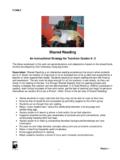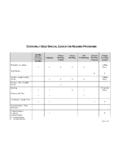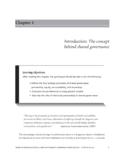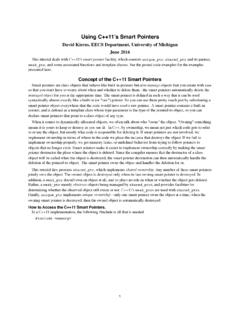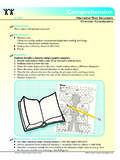Transcription of ACADEMIC READING EXAMPLE - IELTS Help Now
1 ACADEMIC READING EXAMPLE . Read the free sample text below which is taken from ACADEMIC Practice Test 2 and then answer the questions on page 2. The correct answers are on page 3. The Story of the Battery When people consider today how indispensable the Internet is, they often overlook that without electricity, it would not function. Living without the Internet would be a significant inconvenience today, but without electricity, life as we know now it would collapse. Since we started using electricity, which was in the middle of the nineteenth century, we have worked on ways to move and store it easily and efficiently and one of the most common ways of storing electricity has been the battery. A battery does not actually store electricity. A battery, which is actually an electric cell, is a device that produces electricity from a chemical reaction. The story of the battery is one of people trying to create different compounds to create an electric current.
2 The two goals on improving batteries have always been to create ones that can produce an electric current for a long time and to make them smaller and smaller. Alessandro Volta is credited with creating in 1800 the first battery and the first practical method of generating electricity. Luigi Galvani, another Italian scientist and contemporary of Volta, almost made the discovery, but misinterpreted his research results. Using a frog's leg in an experiment, Galvani concluded that the electric current was animal electricity' and did not come from the apparatus he had set up. Volta's battery was made by piling up layers of silver and paper or cloth, soaked in salt, and zinc. These layers were assembled, without paper or cloth between the zinc and silver, until the current was created. Volta's battery was not good for delivering currents for any significant duration. This restriction was overcome in the Daniell Cell in 1820. Using different chemicals, John Daniell used a copper pot, copper sulphate, sulphuric acid and mercury to produce his electric current.
3 Although we now know better than to put mercury into batteries, this battery, which produced about volts, was used to power telegraphs, telephones, and even to ring doorbells in homes for over 100 years. Although many other chemical combinations were used in batteries over the years, the lead acid battery is one that stands out. First made in 1859, it was further improved in 1881 and this design even now forms the basis of the modern lead acid battery found in cars. One very common battery used today is the lithium-ion battery, which was developed by the United States' Central Intelligence Agency (CIA) as a part of their efforts during the Cold War. The idea surrounding the lithium-ion battery was to create a power source that could provide a long- duration, high-density energy supply in a small package. In the early 1960's, both the private and public sectors were experimenting with creating batteries using lithium, but the breakthrough in the chemistry was achieved by adding the ion into the equation.
4 Not long after its invention, the CIA. shared the lithium-ion battery concept with the public and a company working on an exploratory project developed and created the first patent for the lithium-ion battery for commercial use in 1968. Used for a variety of different applications, the first lithium-ion battery was a game-changer in the medical industry, where it is used as the power source in heart pacemakers. Page 1. | All Rights Reserved Questions 1 5. Complete the table below. Write NO MORE THAN TWO WORDS from the text for each answer. Write your answers in boxes 1 - 5 on your answer sheet. Some Older Batteries Battery Notes Volta's Battery * Invented in 1800. * Beat his contemporary, Galvani, who made errors with his (1) _____. * Used silver, paper or cloth, salt and zinc in (2) _____. * Not good for long (3) _____. Daniell's Battery * Made using different chemicals * Used (4) _____, which is not used any more * Produced just over 1 volt and was used for over 100 years The Lead Acid Battery * A significant development from 1859.
5 That still is used in (5) _____ today Questions 6 7. Complete the sentences below. Write NO MORE THAN TWO WORDS from the text for each answer. Write your answers in boxes 6 - 7 on your answer sheet. 6 The lithium-ion battery was invented as part of the United States' contribution to the _____. 7 The _____ that allowed the success of the lithium-ion battery was the chemical addition of the ion to the equation. Page 2. | All Rights Reserved ANSWERS. 1. research (results). 2. layers 3. duration 4. mercury 5. cars 6. Cold War 7. breakthrough Need more practice? Visit the websites below for more IELTS practice tests, complete with audio and answers: Page 3. | All Rights Reserv

